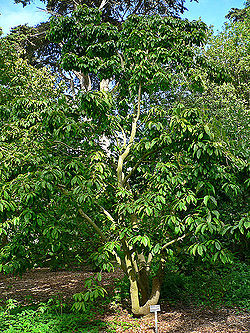Zen magnolia
| Zen magnolia |
|---|

|
| Scientific Classification |
|
| Binomial name |
|
Magnolia zenii |
The Zen Magnolia found in China is home to more species of hardy ornamental plants than any other country in the world, and many western botanical gardens have long histories of introducing them into cultivation. One such "new" plant is Magnolia zenii, an extremely rare, endemic tree from Jiangsu Province, China. It was first collected on March 31, 1933, in bloom, by W C. Cheng in Chu-yun Hsien on Mt. Boa-hua (Paohua), at 250-300 meters in elevation. The tree was first brought into cultivation at the Jiangsu Institute of Botany Institute in October 1980. The Director of this institution presented seeds collected from the only known wild population of M. zenii to Dr.Stephen Spongberg of the Arnold Arboretum. Since then, very few M.Zenii trees are found and absolutely none known species any were outside of china.[1]
Anatomy
The rare, sweetly fragrant, early flowering magnolia was introduced from China in 1977. From fuzzy buds, 10 cm thick, the white petaled flowers are marked with a purple/pink streak that starts at the base of the peddle and fades midway up. The leaves are dark green and smooth on the top side and pale green on the undersides with fuzzy haired veins.These leaves are moderately narrow for a magnolia and are used in Traditional Chinese Medicine and perfumes. The Magnolia grows up to 12 by 6 meters round and up to 16-23 feet tall with gray bark and purplish twigs. Silky hairs cover the winter buds and flowers are highly fragrant, white with purple at the base, Blooming in March to April. Native to woodlands of Jiangsu Province of China, 800-1000 feet altitude this is rare flower blooms at about 7 years old.
Reproduction
Seed Production and Dissemination- The seeds are drupelike, with a soft, fleshy outer seed coat and an inner stony portion. Southern magnolia is a prolific seed producer and good seed crops normally occur every year. Trees as young as 10 years old can produce seed, but optimum seed production under forest conditions usually does not occur until age 25. Cleaned seeds range in number from 12,800 to 15,000/kg and average 14,200/kg. Seed viability averages about 50 percent. The relatively heavy seeds are disseminated mostly by birds and mammals, but some may be spread by heavy rains.
Seedling Development- Seeds usually germinate the first or second spring following seed fall Germination is epidermal. The best natural seedbed is a rich, moist soil protected by litter. Even though viable, seeds rarely germinate under the parent tree because of reported inhibitory effects.
Seedlings are very susceptible to frost damage, and even a light freeze can cause mortality. Partial shade is beneficial for the first 2 years of seedling growth. Under favorable conditions growth is quite rapid. In nurseries, seedlings usually grow 46 to 61 cm (18 to 24 in) the first year.
Vegetative Reproduction- Mature southern magnolia commonly develops root and stump sprouts[]. Portions of lower limbs of saplings often become embedded in the forest floor where they develop roots, eventually producing separate trees. Air-layering, stem cuttings, and grafts have all been used to propagate the species for ornamental plantings.
[Maisenhelder, L. C. 1970. Magnolia. USDA Forest Service, American Woods FS-245. Washington,DC. 7 p.]
[Blaisdell, R. S., J. Wooten, and R. K. Godfrey. 1973. Thirteenth Annual Tall Timbers Fire Ecology Conference. p. 363-397. ] [2]
Ecology
Magnolia zenii, an extremely rare, endemic tree from Jiangsu Province, China is living down to 18 individuals in specific reserves. Full to partial shade is welcomed and rocky soil to clay is best for the hardy Magnolia. Built to withstand the harsh winter chill, it is a wonder to many why this tree is going extinct. [3]
Other
Zen Magnolias are ancient plants. Fossilized specimens of M. Zenii way back from 20 million years ago have been found along with fossils belonging to the entire Magnoliaceae family dating back to 95 million years ago.
Because these plants evolved before bees existed, they developed very tough flowers able to avoid damage from the beetles that pollinated them. Their flowers are thick and strong. They do not have distinct sepals or petals, as more modern flowers do; scientists have named the corresponding part of the magnolia flower a "tepal". [4]
References
- Maisenhelder, L. C. 1970. Magnolia. USDA Forest Service, American Woods FS-245. Washington,DC. 7 p.
- Blaisdell, R. S., J. Wooten, and R. K. Godfrey. 1973. Thirteenth Annual Tall Timbers Fire Ecology Conference. p. 363-397.
- Magnolia Questions and Answers by the US Department of Agriculture
